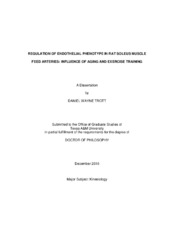| dc.contributor.advisor | Woodman, Chritopher R. | |
| dc.creator | Trott, Daniel Wayne | |
| dc.date.accessioned | 2012-02-14T22:19:03Z | |
| dc.date.accessioned | 2012-02-16T16:14:33Z | |
| dc.date.available | 2012-02-14T22:19:03Z | |
| dc.date.available | 2012-02-16T16:14:33Z | |
| dc.date.created | 2010-12 | |
| dc.date.issued | 2012-02-14 | |
| dc.date.submitted | December 2010 | |
| dc.identifier.uri | https://hdl.handle.net/1969.1/ETD-TAMU-2010-12-8994 | |
| dc.description.abstract | Aging is associated impaired endothelial function in the skeletal muscle vasculature which contributes to decreased ability to increase muscle blow during exercise. This endothelial dysfunction is mediated, primarily, by impairments in the nitric oxide (NO) pathway in the skeletal muscle vasculature. The major purpose of this dissertation is to determine the mechanisms that mediate age-related endothelial dysfunction in rat soleus feed artery (SFA) and determine whether exercise training ameliorates this impairment in endothelial function. Therefore in these series of studies we sought to test three major hypotheses: 1) That exercise training reverses age-related decrements in endothelium-dependent dilation in SFA and that this improved endothelium-dependent dilation is the result of increased NO bioavailability due to increased content and phosphorylation of eNOS and/or increased antioxidant enzyme content; 2) That age-related endothelial dysfunction in rat SFA is mediated in part, by NAD(P)H oxidase-derived reactive oxygen species (ROS); 3) and, that impaired endothelium-dependent dilation in senescent SFA is due to an impaired potential for p-eNOSser1177. To test these hypotheses, SFA from young (4 month) and old (24 month) Fischer 344 rats were isolated for either determination of endothelium-dependent and –independent dilations or biochemical analyses. Results from these investigations suggest that 1) exercise training reverses the detrimental effects of aging on endothelial function in skeletal muscle feed arteries by enhancing the capacity to scavenge superoxide, increasing the bioavailability of NO; 2) ROS contribute to impaired endothelium-dependent dilation in old SFA; whereas, ROS appear to play a role in ACh-mediated dilation in SFA from young rats; 3) and, that the PI3 kinase/protein kinase B (Akt)/eNOS pathway is preserved with age. | en |
| dc.format.mimetype | application/pdf | |
| dc.language.iso | en_US | |
| dc.subject | Nitric Oxide | en |
| dc.subject | Superoxide | en |
| dc.subject | hydrogen perioxide | en |
| dc.subject | endothelial nitric oxide synthase | en |
| dc.title | Regulation of Endothelial Phenotype in Rat Soleus Muscle Feed Arteries: Influence of Aging and Exercise Training | en |
| dc.type | Thesis | en |
| thesis.degree.department | Health and Kinesiology | en |
| thesis.degree.discipline | Kinesiology | en |
| thesis.degree.grantor | Texas A&M University | en |
| thesis.degree.name | Doctor of Philosophy | en |
| thesis.degree.level | Doctoral | en |
| dc.contributor.committeeMember | Crouse, Stephen | |
| dc.contributor.committeeMember | Heaps, Cristine | |
| dc.contributor.committeeMember | Massett, Michael | |
| dc.contributor.committeeMember | Wilson, Emily | |
| dc.type.genre | thesis | en |
| dc.type.material | text | en |




